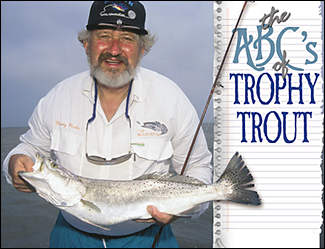
Wallhanger specks - from Baffin Bay or anywhere else -
follow a basic set of behaviors.
Learn their ways, and your trophy room wall
will never be the same.
By Larry D. Hodge
Page 2
As we drifted along, I compared my technique to Panknin's. He's a bigger, stronger guy than I am, and when he whipped the rod tip to make the cork gurgle through the water, water whizzed off the line when it came taut. I struggled to get the line tight enough to make drops drip. Panknin boated one fish after another, but they were all undersized trout or hardheads. I was beginning to wonder if my kinder, gentler technique had a fatal flaw.
Then a fish picked up my shrimp and ran straight at me.

The author is shown here with a 25-1/2-inch trout that he caught off Traylor Island near Rockport.
|
Sure I'd hooked another redfish, I cranked in line as fast as I could until I felt tension, then bent over backward to set the hook. The fish ran left, then right, then straight away. All I could do was hang on and reel when the fish decided to let me.
"It's a big red," I told Panknin.
However, when the fish tired and came to the boat, it flashed silver with black spots, not pink. And it went on forever.
"It's a 24-inch trout," I exclaimed.
"It's bigger than that," Panknin shouted as he grabbed the dip net.
Stretched out on the ruler, the fish went 28 inches with ease. Empty of eggs, it weighed in at a "mere" 6 pounds; when ready to spawn, it would have been that Boone and Crockett 10-pounder we all dream about.
Now is the time to go seeking those major mommas-to-be, Panknin said. "Trout are very temperature sensitive. They like 68- to 74-degree water and will do everything they can to find it. They start spawning when the temperature goes above 70. You have to watch the water temperature and catch them before they spawn, when they are the heaviest."
When seeking spring specks, Panknin says you must get up early. "The fish move up into shallow, grassy water and feed at first light. By 8:30 or 9:00, the water has warmed up and they leave the flats and move back to deeper water. You want to be where you want to fish at very first light," he stated. "That big trout you caught was exactly where it should have been at that time of day, in the shallow water on the back side of a spoil island."
Panknin compares trophy trout to trophy deer. "They didn't get that big by being stupid," he observed. Then he offered these tips for seeking sizable specks.
- When concentrating on quantity, go with live shrimp under a popping cork or use croaker. If the water is clear, you can throw artificial baits.
- If you are going for trophies, wade fish shallow flats and use big topwater baits, or drift over rocks. Throw black back/silver belly floater-diver broken-backs or "true" topwater plugs like the Excalibur Super Spook or MirrOlure Top Dog.
- Most places you can wade where you will find bigger fish offer shallow water with a grassy bottom. Look for concentrations of baitfish first, preferably big mullet. That, after all, is what a big trout feeds on.
- Baffin Bay has shallow rocks, which are a natural reef structure where the food chain starts and attracts the little fish that big trout feed on. Concentrate on those rocks.
- On bright, sunny days in cool weather, trout move up into shallow, clear water and sun themselves. When wade fishing, you can sneak up on them and sight cast to them.
"I believe fish can hear you talking through the bottom of the boat," Panknin said. "With some wind and wave action, that sound is muffled. But on calm days, you will spook them. The noise factor is one reason wade fishing can produce a big fish - provided you slide your feet and be very quiet."
I heartily agree with Panknin's final words of wisdom.
"It's hard to tell somebody what to do," he said, "because there are so many things you do subconsciously. I couldn't walk into your office right now and do the job you do. You can't come to the coast once or twice a month and expect to do what I do for a living every day. Hire a guide, and do what he tells you to do."
(Editor's Note: You can contact Capt. Terry Panknin at 512-992-8368 or 1-800-992-8393.)
# # # #
page 1 / page 2
|





